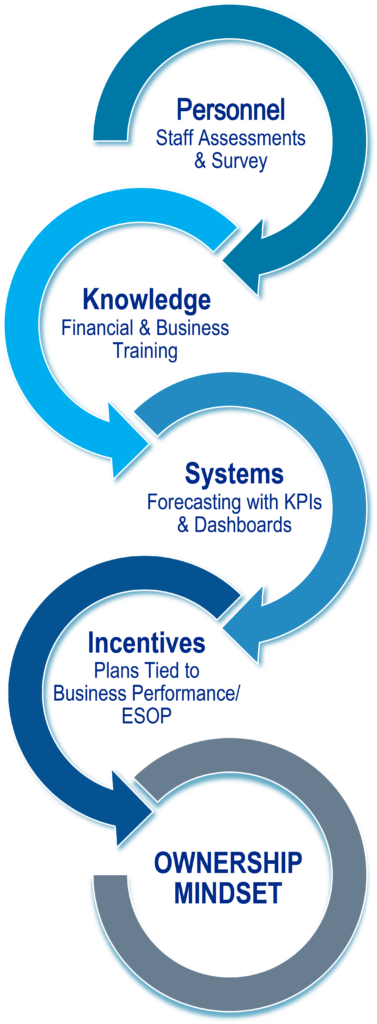
The term “ownership mindset” has become popular in recent years, especially in the business world. It is all about taking responsibility for one’s actions and decisions and treating everything as if it were your own. This mindset is a business model that aims to engage employees and create a culture of accountability, purpose, and profit. Our model combines several management theories, such as open book management, leading indicators, scoreboards, and KPIs, and works well with an Employee Share Ownership Plan (ESOP).
It empowers employees to think and act like business owners while providing them with tools and processes to improve efficiency, better manage projects (improvement plans), and contribute in a more rewarding fashion.
The model comprises four key components:
- People – it is important to have the right people involved, empower them to take action, and ask for their participation.
- Knowledge – employees need to possess business and financial knowledge to make better decisions, not just technical expertise.
- Systems – tracking and measuring relevant KPIs, leading rather than lagging, and regularly reviewing results to take corrective action are crucial elements of the model.
- Incentives – rewarding key improvements that align with business goals, often through an ESOP that provides equity to employees.

According to feedback from clients who have used this model, there has been an improvement in staff involvement, with more ideas and suggestions being shared. Additionally, the relationship between ownership and employees has become better aligned, reducing the occurrence of conflicting views. Most importantly, there has been a noticeable increase in productivity, which is often driven by the employees themselves. Furthermore, profitability has also improved, even after incentives have been paid, as the system is designed to be self-funded.
“The best executive is the one who has sense enough to pick good men to do what he wants done, and the self-restraint to keep from meddling with them while they do it.” – Theodore Roosevelt
Explaining Ownership Mindset:
Empowering employees to take ownership of their work can have a significant impact on the success of a business. This is where the ownership mindset comes in. It is a business model that encourages employees to take responsibility for their actions and decisions, treating the company as if it were their own.
One way to implement the ownership mindset is through an Employee Share Ownership Plan (ESOP). An ESOP is an equity-based plan that allows employees to own a stake in the company. This means that as the company does well, the value of the employees’ shares increases, providing them with a financial incentive to work towards the company’s success.
Combining the ownership mindset with an ESOP can lead to a culture of accountability, purpose, and profit. Employees who have a stake in the company are more likely to think and act like business owners, contributing in a more rewarding fashion. They are also more likely to be engaged and motivated, as they can see the direct impact of their work on the company’s success.
In conclusion, implementing the ownership mindset with an ESOP can lead to a more engaged, motivated, and productive workforce, while also aligning the employees’ interests with those of the company. By empowering employees to think and act like business owners, companies can create a culture of accountability, purpose, and profit.
Interested in offering staff a stake in your business?
Get your free ESS guide.







